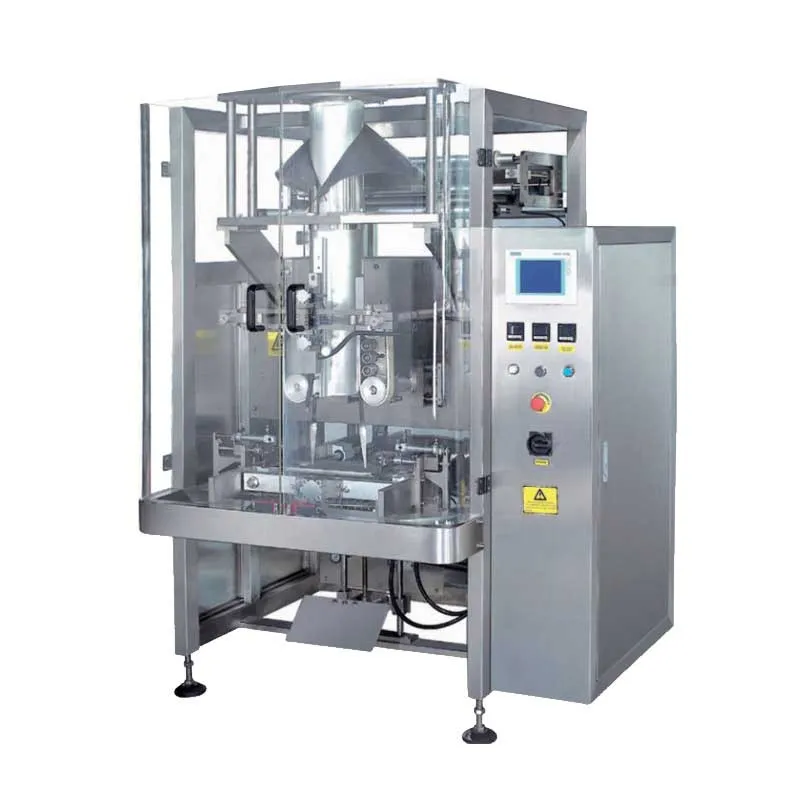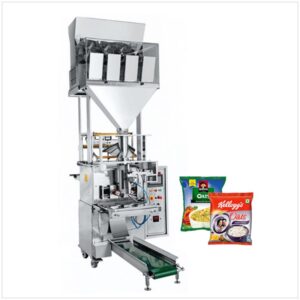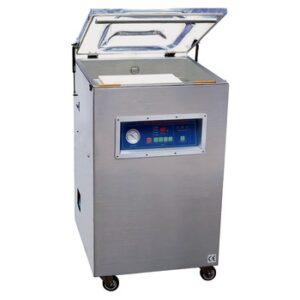Description
| Specification | Description |
|---|---|
| Machine Type | Vertical Form Fill Seal (VFFS) Packaging Machine |
| Packaging Material | Suitable for various heat-sealable films |
| Bag Style | Pillow bags, Gusseted bags, Flat bottom bags, etc. |
| Bag Width Range | 80mm – 500mm (adjustable) |
| Bag Length Range | 100mm – 600mm (adjustable) |
| Speed | Up to 120 bags per minute (depending on the product) |
| Sealing Mechanism | Constant heat sealing or intermittent sealing |
| Film Roll Diameter | Up to 500mm (standard), larger diameters available |
| Power Supply | 220V/50Hz or 380V/50Hz (customizable upon request) |
| Power Consumption | Approx. 5 kW |
| Air Pressure | 0.6 MPa (6 bar) |
| Control System | PLC (Programmable Logic Controller) with touchscreen HMI |
| Optional Features | Date coding, hole punching, nitrogen flushing, etc. |
| Material Construction | Stainless steel (mainly 304 grade), aluminum |
| Safety Features | An emergency stop button, safety guarding, overheat protection |
| Dimensions (LxWxH) | Varies based on model and configuration |
| Weight | Varies based on model and configuration |
Vertical form-fill-seal (VFFS) packaging machines represent the epitome of what can be described as modernity in packaging technologies. VFFS refers to its ability to form a package, fill it with product, and seal it all within one machine that performs this entire process vertically. They have been widely used in various sectors, from food, drugs, cosmetics, and industrial products.
The idea behind VFFS machines is to combine several packaging operations into an automated process eliminating the need for separate equipment and manual interventions. This integration improves efficiency as well as makes the packaging operations consistent and accurate.
There are different types of VFFS machines designed to cater to various packaging requirements including specialist builds with auger or liquid fillers alongside intermittent or continuous motion machinery. They are now found in nearly all modern production lines owing to their flexibility in handling different types of products, package sizes, and volumes produced hence helping manufacturers gain a competitive edge on three fronts – productivity, quality, and cost-effectiveness.
Types of Vertical Form Fill Seal (VFFS) Packaging Machines
Different configurations of vertical form fill seal machines are present to address diverse needs for various packages. The main types include:
Intermittent Vertical Form Fill Seal Machines: Also known as intermittent motion VFFS machines they perform each pack cycle intermittently by stopping at some points along the way while packing powders, grains, or liquids.
Continuous Vertical Form Fill Seal Machines: Continuous motion vertical form-fill-seal (VFFS) machines operate continuously without pausing between cycles, unlike intermittent ones which stop after each cycle. These systems handle high-speed packaging requirements like snacks, candies, and other solid items.
Auger Fill VFFS Machines: These utilize auger fillers that offer precise dosing capabilities for powdered or granulated material making them suitable for packing spices flour among other things.
Liquid Fill VFFS Machines: Designed specifically for packaging liquid products these machines use liquid fillers to ensure accurate measurement and dispense liquids into the packaging material.
Multi-lane VFFS Machines: Multi-lane vertical form-fill-seal machines are used for high-volume production lines where many products are being packed at the same time.
Functions of Vertical Form Fill Seal (VFFS) Packaging Machines
The main functions of VFFS include
Forming: A VFFS machine shapes a film, typically used as packaging material, into a cylindrical shape.
Filling: The formed bags or pouches are filled with solids, liquids, or powders depending on the product type.
Sealing: After filling, the bags are sealed to maintain product quality and reduce the chances of spillage or contamination.
Cutting: The packages are separated from each other by cutting them off from the continuous roll of film after sealing is done.
Working Process of Vertical Form Fill Seal (VFFS) Packaging Machines
A VFFS machine operates through these steps
Material Loading: Film rolls, which act like containers that carry products, are fed into these machines.
Forming: Once it enters the machine films get drawn and shaped tubularly in it.
These machines find applications in various industries such as
The Food Industry: VFFS machines are commonly used for packaging snacks, confectionaries, frozen foods, coffee, spices, and other food products.
Pharmaceutical Industry: In the pharmaceutical industry VFFS machines are used for packaging tablets, capsules, and powders among others.
Cosmetics Industry: They can also be employed for packing creams, lotions, shampoos, and gels.
Pet Food Industry: VFFS machines are also applicable in the pet food sector, especially in packing dry kibble and treats.
Hardware and Industrial Products: Moreover the VFFS machines are used even to pack non-food items like hardware goods or industrial parts.
Advantages of using Vertical Form Fill Seal (Vffs) Packaging Machines
There are several benefits associated with using Vertical Form Fill Seal machines:
High Efficiency: This means that VFFS machines operate at high speed thereby increasing production efficiency and throughput.
Versatility: These units can handle a variety of product forms including solids, liquids, powders, and granules making them versatile across different sectors.
Precision and Accuracy: Advanced filling systems found on VFFS machines ensure accurate dosing as well as consistent packaging results.
Reduced Labor Costs: By automating the packaging process through the use of a VFFS machine manufacturers cut down on manual labor costs saving them money.
Space Saving: Therefore producers can optimize their floor space as these types of machines usually occupy less area per each one of them when compared to other models available on the market today.
Customization Options: Different bag sizes shapes styles may be realized if various settings are altered by this line of equipment to meet specific branding or marketing demands made by customers who are likely to buy certain products from it.
Extended Shelf Life: The hermetic sealing provided by vertical form fill seal (Vffs) ensures that packaged items have a long shelf life because they will not come into contact with moisture, oxygen, or contaminants.
Improved Product Safety and Hygiene: These machines also guarantee a hygienic packaging environment that minimizes chances of contamination as well as upholds product safety.
Cost-effectiveness: Despite consuming a lot of money at the beginning, VFFS machines outdo other ones when it comes to increased output, less wastage, and lower operational expenditure thereby making them cost-effective in the long run.
Environmental Sustainability: VFFS machines help minimize waste resulting from packaging and optimize the utilization of packaging materials hence achieving environmental sustainability.
Frequently Asked Questions
1. What is a Vertical Form Fill Seal (Vffs) packaging machine?
A vertical form fill seal machine is the equipment used in packing products such as foodstuffs, pharmaceuticals, or industrial goods by forming, filling, and sealing packaging material in a vertical orientation.
2. How does the VFFs machine operate?
VFFS works by pulling packaging material from a roll, forming it into a tube shape, and then filling the formed bags or pouches with the desired product. Finally, they are sealed to maintain their freshness and integrity after which they get cut off from what was an ongoing roll production of bags.
3. What types of products can be packaged using vffs machines?
There is no limitation to the types of product forms that can be accommodated by VFFS machines; this ranges between solids liquids powders granules etc. Therefore these machines are versatile for various industries like the food industry, pharmaceutical industry cosmetics industry pet foods industries among others.
4. What are the advantages of using VFFS machines?
Other benefits include high efficiency, versatility, precision, and accuracy during the dosing process offered by special fillers on board as well as lower labor costs due to automated operations which minimize human involvement thus reducing operation expenses.
5. Different varieties of VFFS devices exist today:
The different types of this machine include intermittent motion (impulse), continuous motion (servo), auger-fill vffs, liquid-fill vffs, multi-lane vffs, and others that are specially designed for specific packaging needs.
6. What industries often choose VFFS machines?
VFFS machines are commonly used in the food, drug, beauty products, pet foods, hardware, and industrial products sectors because of their versatility and efficiency in packaging many different types of products.
7. How do VFFS machines contribute to product safety and hygiene?
Through hermetic sealing which minimized the risk of contamination as well as maintained the freshness and integrity during distribution.
8. Do VFFS Machines Accommodate Different Packaging Materials And Sizes?
Yes, such can handle a variety of films, laminates, or foils for packing purposes while also capable of producing bags or pouches with various sizes and shapes for specific packaging requirements.
9. What Factors Should Be Considered In Choosing A VFFS Machine?
The factors that should be considered include the product type being packed, volume of production; compatibility with packaging materials; the desired speed of packaging; level automation; budgetary constraints (cost); and space availability among others.
10. What maintenance procedures are required for VFFS machines?
These involve cleaning, lubricating, checking components, calibrating filling systems, and replacing worn parts to ensure effective performance and durability.





